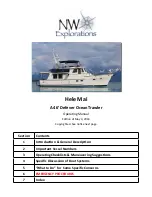
Chaparral utilizes a Lenco™ trim tab retractor. Tab switch integrates a
completely waterproof switch with a trim tab indicator. It is optional on
all new trim tab kits and is able to retrofit the standard tactile switch.
Lenco retractor feature
Lenco marine’s trim tab retractor feature operates from either a 12v-
24v signal or from an engine’s analog tach signal. The purpose of
the accessory signal input is to turn the trim tab control box on and
off. When the control box is turned off, the trim tabs will retract.
Turn-on condition
When the Lenco accessory input is connected to either a 12v-24v
signal or an analog tach signal, the control box turns on and the trim
tab becomes active. At this time the boat operator can run the trim
tabs up or down.
Turn-off condition
If the Lenco accessory input is connected to an analog tach signal,
the control box will shut down when the tach signal is lost (i.e.
engine stalls, stops). If the Lenco accessory input is connected to a
12v-24v source, the control box will shut down when the voltage
source is removed.
Test mode
Lenco marine’s trim tab system includes a test mode feature that
allows the boat operator to by-pass the accessory input signal by
holding down all four buttons on the key pad simultaneously for
approximately three to four seconds. This will turn on the control
box and allow the trim tabs to run up or down.
Once the control box is turned on in the test mode, the boat opera-
tor can turn the control box off by holding down all four buttons on
the key pad simultaneously.
Important: If the control box is turned on in the test mode and
subsequently receives a signal to turn it on via the accessory
input, the boat operator can not turn off the control box by
holding down all four buttons on the key pad. The box will only
turn off by removing the signal from the accessory input.
Refer to your engine manufacturer’s owner’s manual for information
concerning maintenance and operation.
Stopping Your Boat
A boat has no brakes. Stop the boat by allowing it to slow down to
less than 5 miles per hour and then putting the engine in reverse.
Slowly increasing reverse power will allow you to stop the boat in a
short distance. Remember that a boat does not respond to steering
in reverse as well as it does when going forward.
Additional Underway Information
•
Be sure to run the bilge blower whenever the boat is operated
under cruising speed.
•
Keep all bilge blower and engine compartment vents free of
obstructions to allow proper ventilation.
•
Always be aware of local laws on noise limits. Noise means
engine noise, radio noise or even yelling by people on your
boat. Good seamanship demands that you operate your boat
quietly so as not to infringe on the rights of others. Don’t use
thru-hull exhaust unless you are well offshore.
•
You are responsible for any damage or injury caused by your
boat’s wake. Observe no wake speed zone warnings. Operate
your boat with regard for the safety of other boats and people in
your boating area.
5-12
WARNING:
Check behind you before coming OFF plane. Many
accidents occur each year as a result of a driver coming off
plane while being followed by a boat that is unable to slow down
in time to avoid collision.
Summary of Contents for 2009 Sunesta Wide Tech 224
Page 2: ......
Page 4: ......
Page 17: ...1 7...
Page 18: ......
Page 22: ......
Page 24: ......
Page 40: ...2 16...
Page 48: ...3 8...
Page 80: ...5 16...
Page 98: ......
Page 106: ......
Page 112: ......
Page 113: ...WIRING SCHEMATICS 12 12 1...
Page 114: ...12 2...
Page 115: ...12 3...
Page 116: ...12 4...
Page 117: ...12 5...
Page 118: ...12 6...
Page 119: ......
















































